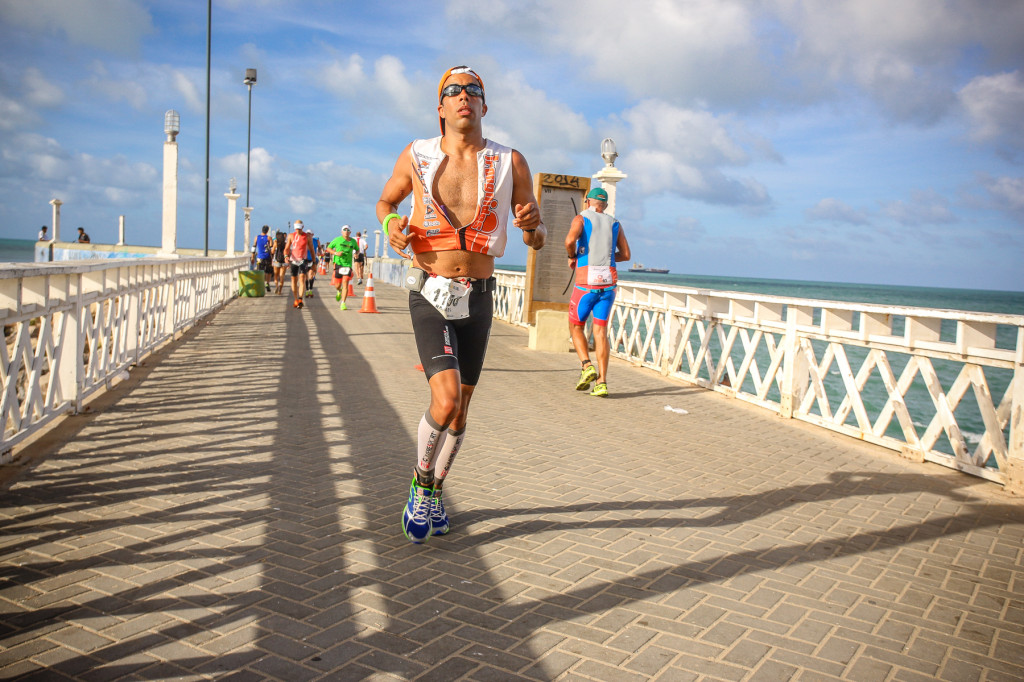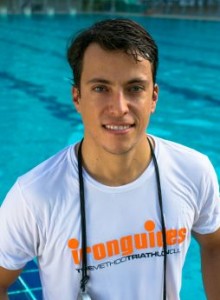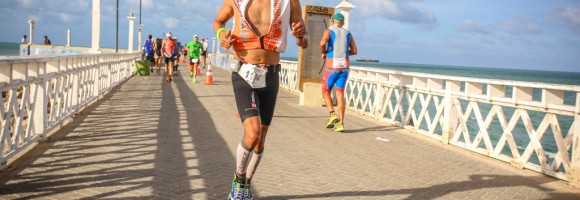The run leg of a triathlon is generally seen as a relationship of “love or hate” by athletes. For a large number of triathletes with a running background and some experience in the discipline, it can be their favorite leg of a race, but there is also the second group, those originating from swimming and cycling, who are faced with a new challenge in the race, and the run leg can be the Achilles heel within the sport.
The article is a guide for both the experienced or beginner runner. You will learn about the main running workouts within a specific training schedule for triathlon and you will also learn the best race day strategy according to your background, body type and swim/ bike fitness.
Types of Workouts
Transition/Bricks
These sessions are crucial and very specific to triathletes. We have two types of brick run sessions:
Cycling + Running: It is the most traditional and challenging as you carry leg fatigue from one discipline to the next. Brick training requires some care, for example an experienced athlete must work several training systems as you will learn below, but make sure that the goal of the workout will not be hindered by the fact that you will be too fatigued. A speed workout with a good technique has to be done when rested rather than when fatigued after a bike session. Another precaution is to avoid doing extremely long run workouts after cycling sessions. This generates an exponential increase in recovery time and injury risk, which will hinder your consistency within your training plan which should be the main goal.
Swimming + Running: A less traditional but important transition is to run after a swim workout. It is not traditional because people consider only local muscle fatigue and the most obvious combination is bike run, but forget that triathlon is three sports and not only one. A low swim training load and skipping this transition training can translate into a very negative result on race day as thefatigue you carry to the bike and run, does not disappear during the race. This type of training is especially important for runners with little experience in swimming, because they will be forced to get used to the fatigue that comes from swimming
Lactate Threshold (Tolerance)
Lactate tolerance is perhaps the most misunderstood system at work in the human body. Largely this lies with the popular misconception that “anaerobic” training begins at the “lactate threshold” level of performance.
In reality, nothing is further from the truth. Anaerobic refers to exertion in the absence of oxygen: A 100m sprint on the track or a 50m all-out swim is truly an aerobic performance. In triathlon, almost none of our training is anaerobic – it is all at varying degrees, aerobic conditioning. No one in triathlon is capable of swimming an anaerobic 100m freestyle effort, for example.
A general rule to achieve the goal of this type of workout is to do sets that are 25-40 minutes long and preferably broken down in shorter intervals so you can achieve the desired intensity even if fatigued and do that while still using good technique.
Work with the ratio 3: 1 or 2: 1 for the work:rest relationship. For example:
10×2 min hard/1 min rest
20×90 sec hard/30 sec rest
5×6 min hard/ 2min rest
Your training plan should highlight lactate tolerance training-both in importance but also on the impact it has on the athlete’s body. A training program is structured to maximize the recovery of this draining type of workout, without compromising consistency or improvement. You need to understand that some athletes are subject to a greater negative response of lactate tolerance training, thus needing more recovery time, and those who need less recovery (since they cannot smash themselves in training) can train this system more often and generally train harder with a higher load.This balance is an individual thing and varies according to gender, age, experience, weight, body type and body composition.

Technique and neuromuscular coordination
Motor coordination is a key element in the race. Have you ever noticed how a good triathlete or marathoner can maintain an impeccable technique in the final kilometers of the race? Even after 90 minutes of running they look as rested as early in the race.
Your goal when racing a triathlon is: TECHNIQUE UNDER DURESS – The use of a movement, or a technique, is only valid if you can apply it under pressure. In sports, pressure means intensity and fatigue. When you think you can least hold a decent technique, is the most important time to do it. In triathlon it means run with a high cadence and good posture even in the last third of the race.
Some key observations and training to develop a good technique and neuromuscular coordination:
*Run cadence always above 90steps per minute (count one side), preferably 96
*Add a neuromuscular and skill set to your run programme, for example 15-30 minutes (depending on experience) with 30 seconds fast @ a high cadence) /30 seconds rest.
*Use the treadmill at 0% incline to help you with your stride rate
*Increase the stride rate in the final third of your long run
Other benefits of these workouts is that you will get aerobic conditioning while training your neuromuscular system, which is usually ignored.
Endurance
Endurance training, is key to the success of a triathlete, but comes with a big dose of hormonal stimuli in its most negative form (increased cortisol, decreased testosterone), so avoid structuring endurance workouts in excess, and mix in speed or strength workouts in your training plan so that the negative effects of endurance training are minimized. By marrying endurance training with efforts that release compensatory stimuli such as speed and strength training, your system will not be overloaded.
It is important that you use some simple principles to ensure that the favorite type of training of a long-distance triathletes do not compromise training consistency.
Some guidelines for your training plan:
* Do not do more than one long session per discipline per week
* If possible space out your long run, swim and long bike by a couple days
* Compensate your long workouts with a speed and strength training session the next day
Speed
Speed work on your run workouts should be planned with extreme care, as excess speed work has a negative return rate, since it requires a lot of recovery time and breaks training consistency.
But to develop your full potential and overcome stagnation in your performances, it is essential that you incorporate some sort of speed work into your training. The guidelines below will help you:
*Keep the repeats short, so you do not overload your aerobic system – 15 to 60 seconds is sufficient
*Use the treadmill or mild descents for increased speed with a lower aerobic load
*Your technique (cadence) is a priority over speed
*Try to do some sets, even if quick, for maintenance, in all weeks of the year
Putting it All Together – The Right Mix
Each type of training comes with a different hormonal response in your body, and each response occurs at different levels depending on aspects such as recovery, duration and intensity of training, diet, sleep, stress and other factors. Understand that the order and structure of your training is a priority as you are training hormonal responses, and must follow a certain order defined by your coach, that way you can train with maximum efficiency(for your situation) while optimizing recovery.
When structured correctly, while you are training a system, another system is resting! This way you are able to train more often, with more consistency and higher quality, reducing the risk of injury.
How to build your training plan:
1) Define with your coach the primary and secondary goal of that training block, and schedule sessions accordingly.
2) If you do two sessions a day, schedule the second workout to train a different system than the first, that way you will not overload yourself negatively and you can train both sessions with a decent intensity and technique.
3) Add technique and neuromuscularwork in your training plan, you can combine it with most other training systems. For example, this can be at the end of a long session or during a speed workout.
4) If your goal is to improve your run leg, take some of the load off your training in the water and on the bike, it is important to run relatively fresh, motivated and ready to push a higher intensity with a good technique. Do not think you can improve a lot at all disciplines at once.
Part 2: Race Day Strategy Understanding the Triathlon Equation: SWIMBIKERUN
Before we discuss the details of how your run will be on race day, you need to understand the strategy you used on the swim and bike and its impact on the run leg.
There are basically three types of triathletes:
Swimmer+Runner: Likely a former swimmer with light body type. However, often due to lack of experience and training time, hasn’t developed enough cycling specific strength.
Swimmer+Biker: Another type with some sort of swimming background, similar to the type mentioned above, but the main difference comes in body type. The swimmer biker is a heavier and generally more powerful athlete, which is great to push big gears on the bike and ride fast, but too heavy to run efficiently and fast.
Biker+Runner: Generally from a running background, has a huge aerobic engine and high power to weight ratio. However it is likely that this athlete has not had swimming lessons as a child and results in a disadvantage in that discipline. The typical thinking when you see them in a race is “if that athlete could swim, he would be unbeatable in triathlons”
Which is the best strategy for each of these types?
Option1–Walk+Run:
Structuring walk breaks during your race (and in training!), is a great option for beginner athletes in shorter events, or intermediate athletes in longer races.
The main benefit is motivation, since to complete anywhere from 5k to 42k without taking a break can be close to impossible to a large number of athletes. However, these athletes will still give it a go and see if they can manage the challenge, only to realize it was indeed not possible and they are forced to a walk. Once forced to walk in a race, that will come partially as a failure, that you are just not fit enough and that your perfect race day is out of the window at that moment, your goal from now is only to finish the event and cover the distance.
Alternatively, if you aren’t completely sure you can cover the run leg without a break, consider taking small walk breaks during the race.The most used strategy for beginners is taking a one minute walk for every ten minutes of running. Intermediate athletes may structure their walk breaks by walking all stations that are usually 2km apart which is just over ten minutes of running.
When you structure breaks, walking is still part of your perfect day, even how you walk would be different to the “just want to finish” type of walk. A confident, faster walk, chin up, as opposed to a heads down, slow slog. Mentally, it is also easier to break a big task into small steps, you only need to focus on running the next ten minutes instead of running the entire length of the course which can be mentally very challenging.
Another benefit of this strategy is a better opportunity for hydration and calorie intake during aid stations as it is easier to drink or eat while you are walking rather than running.
In training, including walking breaks means you will be running faster and with a better technique as compared to a run only strategy, as once you start to fatigue, you lose your technique and slow down, as opposed to taking a break every once in a while then resuming running fresher again. The main benefit of this strategy in training is that you reduce chances of injury due to the better technique and faster stride rate.
The biggest challenge of this walk:run strategy is to overcome your own ego and that it is acceptable to walk in a triathlon race. Make sure you also ignore spectators that will be encouraging you to get back to running if they see you walking, just switch off the noise and focus on your own race. Once that happens and you apply this strategy in your races, you will start to see faster run splits.
Option 2 – Negative Split:
The term “negative split” means the second part of your race or training, is faster than the first.
One of the biggest benefits of running with the negative part is feeling very good and strong towards the end of a race while all athletes around you are slowing down. Mentally, this can mask some of the pain you are going through and make you go faster
In physiology terms, you have a limited amount of kilometers that you can go hard, once that number is reached (sudden increase of lactic acid inyour system), you can’t recover from that effort fast enough, thus forcing you to slow down. Save your highest effort for the final kilometers of the race.
This is a strategy that should also be used in training, as now you create the habit of always finishing stronger than you started, but you will also go hard when fatigued, thus creating an ‘insurance’ that you won’t be able to run extremely fast, which for most athletes is not specific enough for their races and the benefits come with a lot of drawbacks, mainly related to recovery timeand injuries. A hard run on fatigued legs is like having an insurance policy that you will stay consistent in training.
Option 3 –Positive Split:
Having a positive split is something that only a minority of triathletes should do and won’t apply for 99% of the readers of this article, but as a ‘Complete Guide’ to running is important to explain this possibility as it will also help you to not to aim for such.
The positive split, as the name suggests, is exactly the opposite of the negative split. The first half of the run leg is done faster than the second. The main benefit of this strategy is a combination of positioning yourself ahead of your usual competitors or your goal, thus creating a scenario where you will be so motivated to hold that advantage that you will motivate yourself to a new level and will also help you handle fatigue and pain for longer and at a higher intensity.
Visualize a high performance age grouper starting the run of an Olympic Distance race with 1h20min, this athlete has never been able to break the forty minute mark in a 10k run, but this time he decides to take a risk and goes through the first 5k in 19min30sec, that way he has created a cushion of 30 seconds to break two hours for the race and also to break forty minutes on the ten kilometer run leg.
That margin will fade away as the pace was stronger than he should have done, but he may be ableto dig a little deeper than the usual due to the opportunity of a breakthrough performance in his overall time and run leg split.
Another example commonly practiced by professional or high performance triathletes is to exit the transition at a much stronger pace than is planned to hold for the rest of the race, that way the top athletes of the race will drop the weaker athletes and not allow them to take advantage of running in a group or pace themselves from the faster athletes. Just like in cycling, at a very high level of running, to position yourself in the middle of a group will make running easier as your effort shifts from setting your own pace which can be mentally draining, to only have to ‘sit in’ the pack. There is also a marginal gain with less wind resistance.
I believe that most readers of this article will have better performance using options 1 and 2. Option 3 requires a high level of fitness (semi-professional or professional). You can also discuss with your coach the possibility to participate in smaller events and to try various strategies and test what works best for your goal.
Enjoy your training,
Vinnie Santana

ironguides is the leading Lifestyle Facilitation company for athletes of all abilities. We provide coaching and training services, plans and programs, as well training education, health and fitness products to help you learn and live a healthy lifestyle. Come get fit with one of our monthly training subscriptions, event-specific training plans, coaching services, or a triathlon training camp in an exotic location! ironguides also provides Corporate Health services including Corporate Triathlons, Healthy Living retreats and speaking engagements. At ironguides, your best is our business!
Train with ironguides!
Personalized Online Coaching: Starting at USD190/month
Monthly Training plans (for all levels, or focused on one discipline): Only USD39/months
Event based training plans:
Sprint Distance (USD45 for 8-week plan)
Olympic Distance (USD65 for 12 week plan)
Half Ironman (R$95 for 16-week plan)
Ironman (USD145 for 20-week plan)
X-Terra (USD65 for 12-week plan)
Running Plans (10k, 21k and 42k – starting at USD40)


Recent Comments